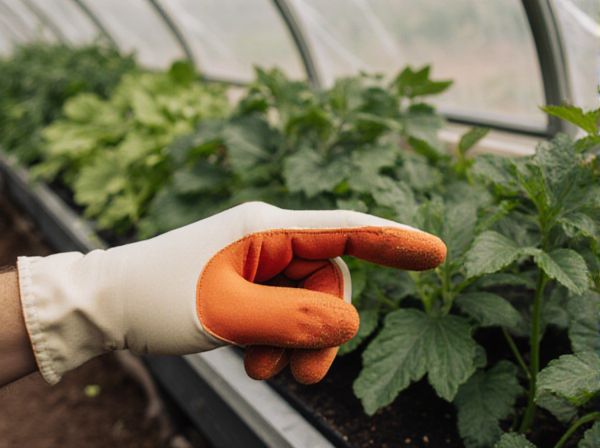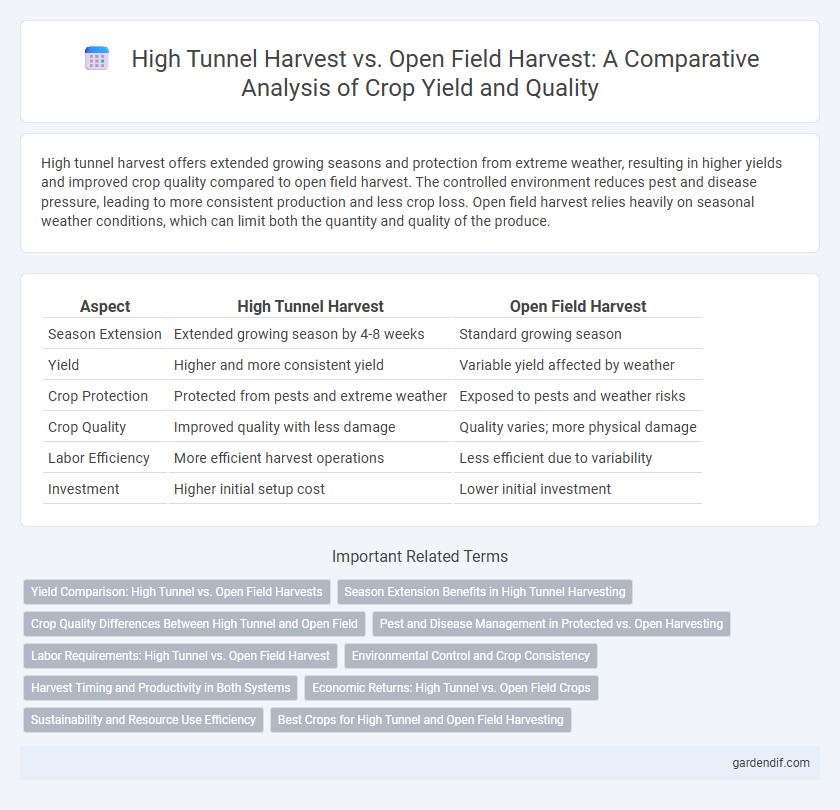
High tunnel harvest vs Open field harvest Illustration
High tunnel harvest offers extended growing seasons and protection from extreme weather, resulting in higher yields and improved crop quality compared to open field harvest. The controlled environment reduces pest and disease pressure, leading to more consistent production and less crop loss. Open field harvest relies heavily on seasonal weather conditions, which can limit both the quantity and quality of the produce.
Table of Comparison
| Aspect | High Tunnel Harvest | Open Field Harvest |
|---|---|---|
| Season Extension | Extended growing season by 4-8 weeks | Standard growing season |
| Yield | Higher and more consistent yield | Variable yield affected by weather |
| Crop Protection | Protected from pests and extreme weather | Exposed to pests and weather risks |
| Crop Quality | Improved quality with less damage | Quality varies; more physical damage |
| Labor Efficiency | More efficient harvest operations | Less efficient due to variability |
| Investment | Higher initial setup cost | Lower initial investment |
Yield Comparison: High Tunnel vs. Open Field Harvests
High tunnel harvests consistently produce higher yields than open field harvests due to enhanced microclimate control, which extends the growing season and reduces crop stress. Studies show that crops grown in high tunnels can yield 20-50% more compared to those harvested in open fields, largely because of improved temperature regulation and protection from environmental extremes. Increased yield not only boosts profitability but also allows for more efficient land use and resource management in high tunnel systems.
Season Extension Benefits in High Tunnel Harvesting
High tunnel harvests significantly extend the growing season by providing a controlled environment that protects crops from early and late-season frost, enabling production weeks earlier and later compared to open field harvest. This season extension results in higher yields, improved crop quality, and the ability to market fresh produce during periods of limited supply. Farmers benefit economically by accessing premium prices and meeting consumer demand beyond traditional outdoor growing seasons.
Crop Quality Differences Between High Tunnel and Open Field
High tunnel harvest consistently yields superior crop quality due to controlled environmental conditions that reduce exposure to pests, diseases, and adverse weather. This protection enhances fruit color, firmness, and flavor intensity compared to open field harvests, where crops face greater variability and stress factors. As a result, high tunnel-grown produce often commands higher market value due to better shelf life and visual appeal.
Pest and Disease Management in Protected vs. Open Harvesting
High tunnel harvests significantly reduce pest and disease pressure compared to open field harvesting by creating a controlled environment that limits exposure to external pathogens and insect vectors. The physical barrier of the high tunnel restricts entry for common pests such as aphids and cucumber beetles, while improved air circulation and soil management help minimize fungal diseases like powdery mildew and downy mildew. Unlike open fields, where weather variability and pest migration complicate management strategies, high tunnels allow for targeted interventions and reduced pesticide applications, enhancing crop health and yield stability.
Labor Requirements: High Tunnel vs. Open Field Harvest
High tunnel harvests demand less labor per acre compared to open field harvests due to extended growing seasons and improved crop protection, resulting in higher yields with fewer interventions. Labor efficiency increases as high tunnels enable early planting and reduce the time spent on pest control and weather-related damage mitigation. Conversely, open field harvests require more intensive labor inputs for managing variable weather conditions and pest exposures, often leading to increased crew sizes and longer working hours.
Environmental Control and Crop Consistency
High tunnel harvests offer superior environmental control by protecting crops from extreme weather, pests, and diseases, resulting in more consistent crop quality and extended growing seasons. Open field harvests are subject to variable weather conditions and pest pressures, which can lead to fluctuations in crop yield and quality. The controlled microclimate within high tunnels enhances crop uniformity and reduces the risk of crop failure compared to open field cultivation.
Harvest Timing and Productivity in Both Systems
High tunnel harvests enable earlier crop production, often advancing harvest dates by 2 to 4 weeks compared to open field systems, which is crucial for market timing and premium pricing. Crop yields in high tunnels typically increase by 20-50% due to controlled environmental conditions that reduce pest pressure and extend the growing season. Open field harvests, while more variable due to weather dependency, can support larger-scale production but often result in lower productivity and delayed harvest timing.
Economic Returns: High Tunnel vs. Open Field Crops
High tunnel harvests consistently yield higher economic returns compared to open field crops due to extended growing seasons and increased crop quality. The controlled environment reduces crop losses and improves market timing, resulting in premium pricing and higher profitability. Investment in high tunnel infrastructure typically pays off through increased yields and reduced input costs, making it a financially advantageous choice for many growers.
Sustainability and Resource Use Efficiency
High tunnel harvests significantly enhance sustainability by extending the growing season and reducing the need for chemical inputs through improved pest and disease control. Resource use efficiency is optimized with controlled water application and minimal nutrient runoff compared to open field harvests, which often face higher water evaporation and soil erosion. These factors contribute to a lower environmental footprint and increased crop yield consistency in high tunnel systems.
Best Crops for High Tunnel and Open Field Harvesting
High tunnels optimize growing conditions for crops like tomatoes, cucumbers, peppers, and leafy greens by extending the growing season and protecting against adverse weather, resulting in higher yields and improved quality. Open field harvesting is ideal for root vegetables, field corn, wheat, and soybeans, which thrive in natural environmental conditions with ample space and direct sunlight. Selecting the best crops is crucial for maximizing productivity, with high tunnels favoring heat-loving and tender crops, while open fields support hardy and large-scale staple crops.
High tunnel harvest vs Open field harvest Infographic

 gardendif.com
gardendif.com